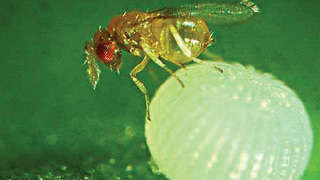
Organic FarmingAgroStar Agronomy Centre of Excellence
Trichogramma - an egg-parasitioid eco-friendly pest
The biological-pest control system is one of the important components of integrated pest management and its use is effective. Our friendly pest is 'Trichogramma chilonis', which survives on numerous pests. 3 different species of Trichogramma sp are parasitises on eggs of insect pest.
Lifecycle
The stage of Trichogramma's eggs lasts 16–24 hours, and after that larva emerges. Larval stage lasts for 2-3 days and feeds on pests eggs. Therefore, it does not allow pests to multiply. Then Larva goes into pupal stage, in which it lasts for 2-3 days. On the 7th or 8th day, Trichogramma comes out from the pupae. The adult Trichogramma, which has come out of the pupae, lives for 24–48 hours. The adult Trichogramma wonders into the field for 2 to 3 days, looking for the eggs of the moth and lays eggs in it. In this way, the life cycle of Trichogramma insect gets completed.
Trichogramma pest control method
Trichogramma friendly insects are produced in the laboratory. In the laboratory, insects found in paddy the cards thus prepared by placing eggs from the female of Trichogramma in an artificial manner on the pest eggs found in paddy are given to the farmers. There are about 18 to 20 thousand eggs on such a card. Straps of this card can be made and tied on the leaves of the crop in the field by stapler or thread. When this parasite, Trichogramma, is released into the field, the female eggs find the eggs laid by the insect in an area of 5 meters in diameter, and the female kit lays eggs on it. A female locates eggs of harmful pests and lays 2 to 6 eggs in 1 egg. After hatching of Trichogramma the eggs are eaten inside the eggs of the harmful insect and then go into a calf. In this whole process, the living part of the harmful insect's egg is eliminated and the living insect does not exit the egg. In this way, Trichogramma destroys the enemy insect, so the losses can be avoided.
Source: AgroStar Agronomy Centre of Excellence
If you find this information useful, click on the yellow thumb impression below the photo and share it with your farmer friends through the options below.
524
1

